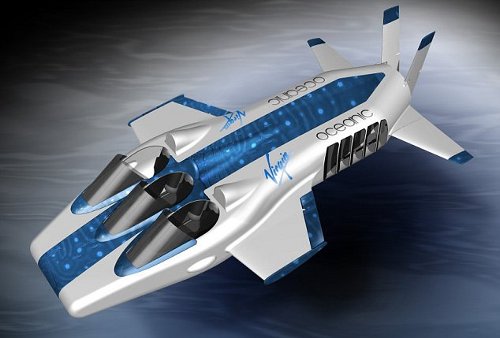
Welcome to MSW’s Scuttlebutt! Here’s the news for the day.

Feature - Water-line Conversion of Injection Molded Full Hulls
MSW crew-mate Kym Knight (Rab) shares a treatise on his technique of converting full hull model kits to water-line style, in this step-by-step tutorial feature.

Branson Goes 20,000 Leagues Under the Sea
Source: CNN Money
NEW YORK -- Virgin unveiled the latest addition to Richard Branson's luxury fleet on Friday: an underwater plane that will fly riders into the depths of the Caribbean Sea.
Guests on Necker Island, a retreat in the British Virgin Islands, will be able to dive underwater in a submarine dubbed the Necker Nymph for $25,000 a week. But that's only after shelling out around $300,000 for a one-week stay on Necker, the private island owned by billionaire and Virgin Group chairman Richard Branson.
Beginning on Feb. 20, two riders and a pilot and will be able to take the plunge from land, or from a boat. The underwater plane uses the downward pressure on its wings to fly through the water for up to two hours at a time, while an open cockpit will give riders a 360-degree view.
The Necker Nymph's typical speed is 2 to 5 nautical miles per hour and it can dive more than 100 feet, said Karen Hawkes, a spokeswoman for Hawkes Ocean Technologies, the company that designed the Nymph.

A statement released Friday by Virgin Limited Edition, the luxury arm of Virgin Hotels, described the Nymph's launch like a plane's takeoff. "Gliding on the water's surface like an aeroplane on a runway, one of the three pilots will operate the joystick to smoothly dive down."
Vacationers will be able to fly the Necker Nymph while chartering the Necker Belle, Branson's 105-foot yacht, or the submarine can be launched from shore. Necker Belle is rented out to guests for $88,000 a week, bringing the full Necker Island experience to more than $400,000 per week.
Riders must follow SCUBA procedures and be trained or accompanied by a certified pilot before entering the underwater plane. SCUBA tanks are mounted in the submarine and passengers must wear masks while underwater, said Hawkes.
The Necker Nymph claims "near-zero" environmental impact because its "positive buoyancy prevents the sub from landing on a reef, and its low light and noise emissions ensure the fragile ocean ecosystems remain undisturbed," Virgin said.
A New Generation Swedish Submarines
Source: Kockums AB
The Swedish Government has approved initiation of the design phase for a new generation submarines for the Royal Swedish Navy.
The new generation, denominated A26, will be designed for mainly littoral operations but will also possess ocean-going capabilities. It will be powered by a conventional diesel-electric propulsion machinery, and equipped with Kockums Stirling AIP system (air-independent propulsion). The Stirling system, together with a set of balanced underwater signature properties, will make the A26 submarine very stealthy and difficult to detect. It will also be higly invulnerable to underwater explosions through a verified shock resistance.
The A26 design includes a new innovative flexible payload capability with a flexible payload lock system in addition to its conventional torpedo tubes. Furthermore it will be prepared for network connectivity. A highly modular design facilitates efficient through-life upgrades and adaptations.
Project status
Initiation of the design phase for the next generation Swedish submarines was approved by the Government in December 2007.
Preparations are currently ongoing together with the Swedish Defence Materiel Administration (FMV), to enter into a design contract for the A26 submarine.
American Spy Goof-Up: China Navy Report Posted On Web (excerpt)
Source: Indian Business Standard
NEW DELHI --- A mistake by a US Navy intelligence official has given the world an unexpected peek into the secret world of China’s navy. The US Office for Naval Intelligence (ONI) committed the blunder of posting, on an open website, the agency’s assessment of the state of the Chinese navy. Before the ONI could rectify this indiscretion by pulling off the report, it had been downloaded and posted on a publicly accessible website.
The 47-page report, entitled, “A modern navy with Chinese characteristics”, is still posted on the website of the Federation of American Scientists, a policy advocacy body (http://www.fas.org/irp/agency/oni/pla-navy.pdf).
The ONI report analyses the capabilities and the future direction of the People’s Liberation Army (Navy), or PLA(N). Interestingly, the ONI assessment differs substantially with the conventional view — widely prevalent in India and the Indian Navy — of a China racing unstoppably towards naval superpower.
The assessment notes China’s recent deployment of Task Groups — each consisting of two warships and a replenishment vessel — for anti-piracy operations in the Gulf of Aden. This marks the first time in over 600 years that a Chinese flotilla has operated in waters beyond China’s immediate vicinity.
But the report concludes, “none of these operations indicates a desire on the part of the People’s Republic of China (PRC) to develop a constant global presence. Beijing’s ambition appears to remain focused on the East Asian region, with an ability to protect the PRC’s maritime interests in distant seas when required.
The PLA(N)’s most key acquisition, says the ONI report, is a sophisticated anti-air capability, which would allow its ships to operate in “distant seas”, far from land-based air-defence systems. The Luyang-I class of destroyers, already formidable, have been followed by the Luyang-II class and the Jiangkai II frigates, which are linked with an air-surveillance network as good as America’s world-standard Aegis system.
The ONI report says that Beijing will replace its large number of low-tech submarines with “smaller numbers of modern, high-capability boats (submarines)”. But, while the number of surface ships remains constant, today’s fleet of 62 submarines will increase over the next 10-15 years to 75.
In that time-frame, India’s submarine fleet will be about one-third that of China’s.
Most worrisome for the US Navy’s pre-eminence in the region is the programme to develop the world’s first Anti-Ship Ballistic Missile (ASBM), a variant of China’s Dong Feng–21 missile. The ONI report reveals that the ASBM’s peculiar flight path, involving a mid-course trajectory correction, will make it very difficult to intercept.
Despite the addition of high-tech platforms, US intelligence estimates that much of the PLA(N) will still remain outdated 10-15 years from now. Its surface ships will remain vulnerable to air attack, while command and control systems will still be relatively undeveloped.
Therefore, while the PLA(N) will be gradually expanding beyond the South China Sea, it will focus on what Beijing calls, “military operations other than war.” These include protecting its international lines of supply, humanitarian relief, and naval diplomacy.

Navy to Formally Induct MiG-29K Naval Fighter Jets
Source: ddi Indian Government news
The [Indian] Navy will formally induct the Russian-made MiG-29K naval fighter jets for deployment on Admiral Gorshkov aircraft carrier on 19th February in Goa.
The first four of the 16 MiG-29Ks that India had bought from Russia in 2004 along with Gorshkov were delivered at the INS Hansa naval base in Goa on 4th December last.
"The formal induction ceremony has been fixed for February 19 at INS Hansa. The squadron has been named Black Panthers," a Navy spokesperson said in New Delhi on Tuesday.
The fighter jets that arrived in Goa in a knocked-down condition in a transport plane were re-assembled at INS Hansa, which also has a maintenance and training facility for the aircraft and its pilots.
"At present the Russian technicians and pilots are based in Goa to do the reassembling and training our technicians and pilots to take over maintenance and operations soon," he said.
After induction, the fighter jets would be operated temporarily from the shore-based facility at INS Hansa till the actual delivery of Gorshkov, rechristened as INS Vikramaditya, slated for 2012.
Under the USD 1.5 billion deal signed in March 2004 for the 45,000-tonne Kiev class Gorshkov and the MiG-29Ks, USD 974 million went towards the warship and USD 526 million for the fighter jets.
Of the 16 jets, 12 are MiG-29K single-seater fighters and the rest four are MiG-29KUB twin-seater trainers.
India is all set to ink another deal with Russia for 29 more MiG-29Ks for USD 1.2 billion in a bid to strengthen its naval aviation wing.
The MiG-29Ks flight operations on Gorshkov will be in the Short Take Off But Arrested Landing (STOBAR) configuration for which the ship is being re-modified at Sevmash yard in Russia.
To train Indian pilots for STOBAR operations, India has already set up the world's third shore-based training facility at INS Hansa.
The pilots were also sent to the US for deck landing training and on board a French aircraft carrier for operations training, apart from Russia for Qualified Flying Instructors' conversion training.
The aircraft has arrester gear on its tail to help hooking onto the arrestor wires on board the landing deck of the carrier.
It also has stronger landing gear to withstand the arrested landing on board the carriers, folding wings and rust-proofing to prevent corrosion.
Fitted with a fully digitised glass cockpit, improved engine protection against ingestion of foreign particles like birds, a multi-mode radar and increased range, the MiG-29Ks will also provide aerial cover to the carrier's battle group, acquire air superiority and destroy sea-borne and ground-based targets with guided high-precision weapons in all weather, day-and-night conditions.
India currently operates the Sea Harrier jump jets on board its solitary Centaur Class aircraft carrier, which celebrated its 50 years of naval service both in the Royal Navy as HMS Hermes and in the Indian Navy as INS Viraat.
Of the 30-odd Sea Harriers the Navy bought from Britain along with Viraat in late 1980s, only a dozen of them are left in service.

USS Kitty Hawk CVA/CV-63 Veterans Association
Today’s website is the USS Kitty Hawk CVA/CV-63 Veterans Association. Enjoy.
This Day in U.S. Naval History
1801 - The U.S. Senate approves a peace treaty with France, ending an undeclared naval war which began in 1798.
1917 - The United States severs diplomatic relations with Germany.
1991 - Battleship USS Missouri (BB 63) fires eight 2,000-pound shells from her 16-inch guns, destroying prefabricated enemy concrete command and control bunkers Iraq is moving into Kuwait.
Photo of the Day

Aviation Boatswains Mate (Handling) 3rd Class Marcialiced Arrendondo, left, and Aviation Boatswains Mate Airman Christina Marszalek build a snowman on the flight deck of the amphibious assault ship USS Kearsarge (LHD 3) during a snow storm off the coast of Virginia.
Gator











